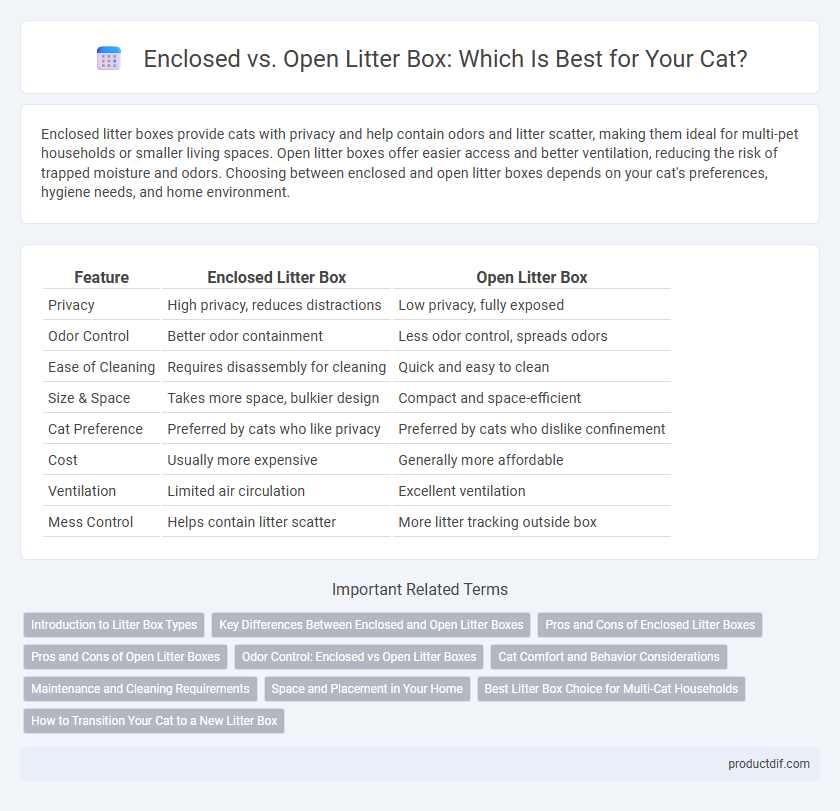Enclosed litter boxes provide cats with privacy and help contain odors and litter scatter, making them ideal for multi-pet households or smaller living spaces. Open litter boxes offer easier access and better ventilation, reducing the risk of trapped moisture and odors. Choosing between enclosed and open litter boxes depends on your cat's preferences, hygiene needs, and home environment.
Table of Comparison
| Feature | Enclosed Litter Box | Open Litter Box |
|---|---|---|
| Privacy | High privacy, reduces distractions | Low privacy, fully exposed |
| Odor Control | Better odor containment | Less odor control, spreads odors |
| Ease of Cleaning | Requires disassembly for cleaning | Quick and easy to clean |
| Size & Space | Takes more space, bulkier design | Compact and space-efficient |
| Cat Preference | Preferred by cats who like privacy | Preferred by cats who dislike confinement |
| Cost | Usually more expensive | Generally more affordable |
| Ventilation | Limited air circulation | Excellent ventilation |
| Mess Control | Helps contain litter scatter | More litter tracking outside box |
Introduction to Litter Box Types
Enclosed litter boxes provide privacy and help contain odors, making them ideal for cats that prefer a secluded space while reducing litter scatter around the area. Open litter boxes offer easy access and ventilation, which some cats favor for comfort and cleanliness. Choosing between enclosed and open litter boxes depends on the cat's behavior, litter habits, and the owner's preference for odor control and maintenance.
Key Differences Between Enclosed and Open Litter Boxes
Enclosed litter boxes feature high walls and a cover, which help contain odors and litter scatter, providing cats with privacy and reducing mess. Open litter boxes lack a cover, offering easy access and ventilation but can result in more odor dispersion and litter tracking. Choosing between the two depends on factors like a cat's preference, odor control needs, and available space in the home.
Pros and Cons of Enclosed Litter Boxes
Enclosed litter boxes offer privacy and reduce litter scatter, making them ideal for maintaining a cleaner environment in homes with active pets or small children. They help contain odors better than open boxes but may trap moisture, requiring frequent cleaning to prevent mold and bacteria buildup. Some cats may feel confined or uncomfortable inside enclosed boxes, potentially leading to litter box avoidance.
Pros and Cons of Open Litter Boxes
Open litter boxes offer easy access for cats, encouraging frequent use and simplifying cleaning routines; however, they lack odor containment and can allow litter to scatter outside the box, creating messes in the surrounding area. Their design promotes ventilation, which helps reduce moisture buildup but may not provide privacy for shy or anxious cats, potentially deterring usage. Open litter boxes are typically more affordable and come in various sizes, making them suitable for households with multiple cats, though they require regular maintenance to control odors and litter tracking.
Odor Control: Enclosed vs Open Litter Boxes
Enclosed litter boxes provide superior odor control by trapping smells inside the box, reducing the spread of unpleasant odors throughout the home. High-quality models often feature carbon filters or tight-sealing lids that further minimize odor leakage. In contrast, open litter boxes allow odors to disperse freely, requiring more frequent cleaning to maintain a fresh environment.
Cat Comfort and Behavior Considerations
Enclosed litter boxes offer cats a sense of privacy and security, which can reduce stress and encourage consistent use, especially for shy or anxious felines. Open litter boxes provide better ventilation and visibility, helping cats feel less confined but may expose them to more odors, potentially deterring use. Cats' preferences vary, so observing behavior and comfort levels is key to selecting the optimal litter box that promotes healthy elimination habits.
Maintenance and Cleaning Requirements
Enclosed litter boxes typically require more thorough cleaning due to restricted airflow, which can trap odors and moisture, potentially leading to bacterial buildup if not maintained regularly. Open litter boxes allow for easier and faster scooping and air circulation, reducing odor retention and making daily maintenance simpler. Choosing between the two depends on the pet owner's willingness to commit to frequent cleaning and the cat's preference for privacy versus ventilation.
Space and Placement in Your Home
Enclosed litter boxes are ideal for homes with limited space, as their compact design helps contain litter and odors, making placement in smaller or high-traffic areas more manageable. Open litter boxes require more room for easy access and are best suited to spacious spots where pets can move freely without feeling confined. Consider your home layout and available space to choose the litter box that balances pet comfort with practical placement.
Best Litter Box Choice for Multi-Cat Households
Enclosed litter boxes provide odor control and privacy, making them ideal for multi-cat households where minimizing litter scatter and containing smells is crucial. Open litter boxes allow for easier access and monitoring of cat waste, which helps in detecting health issues quickly but may lead to more mess in busy environments. Choosing the best litter box depends on the number of cats, their preferences, and the household's need for cleanliness and odor management.
How to Transition Your Cat to a New Litter Box
Transitioning your cat to a new litter box requires patience and consistency to ensure comfort and reduce stress. Place the new enclosed or open litter box near the old one, gradually moving it to the desired location while keeping the old box accessible during the adjustment period. Use familiar litter and clean both boxes regularly to encourage your cat to explore and accept the new setup.
Enclosed Litter Box vs Open Litter Box Infographic

 productdif.com
productdif.com